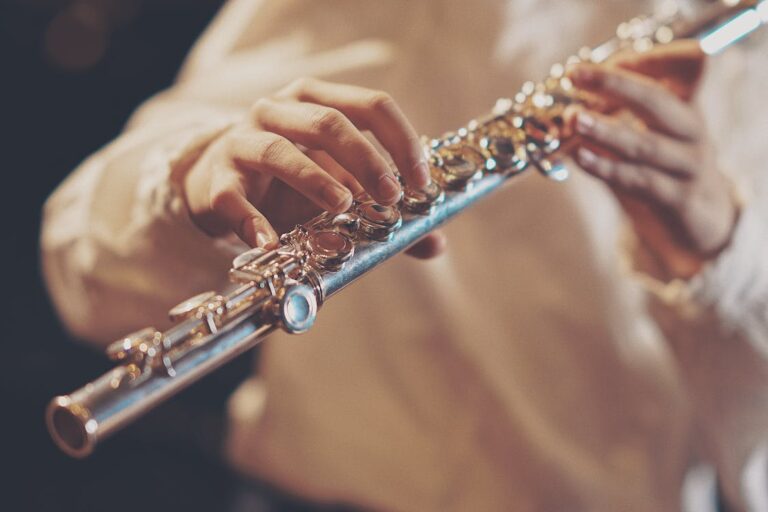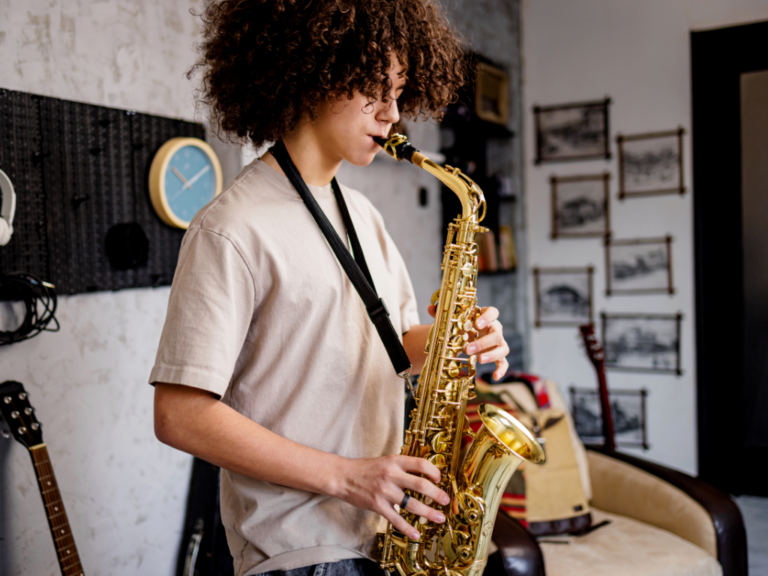Looking After Your Wind Instrument: A Helpful WA Music Guide
Wind instruments require a little more maintenance than string instruments and brass instruments. Wind instruments are usually made of metal (flute, saxophone) or wood (oboe, clarinet, bassoon) and involve blowing through a mouthpiece and/or reed to create a sound that travels down the length of the instrument.
Looking after your wind instrument involves making sure the instrument is clean, stored properly, and that the smaller moving parts of the instrument are kept in good condition. Read on to find out how to properly look after your wind instrument!

Looking After Your Flute
Handle with Care: Treat the flute gently. Always hold it by the designated areas, usually the middle joint and the end of the foot joint. Avoid gripping the keys tightly or putting excessive pressure on any part of the instrument. The keys are metal and are prone to bending. Therefore, excessive force will warp the keys and prevent the pads from closing.
No Food or Drink Before Playing: Avoid eating, drinking, or chewing gum before playing the flute. Food particles and liquids can damage the keys, pads, and interior mechanisms. Brushing your teeth before playing is highly recommended.
Clean and swab out after each use: After each playing session, wipe the flute’s exterior and keys with a clean, soft cloth to remove moisture, fingerprints, and oils from your hands. Use a cleaning rod and cleaning cloth to swab the interior of the flute to remove moisture. Gently insert the cleaning rod into each section of the flute (head joint, body, foot joint) and carefully rotate it while holding the flute vertically.
Storage: Always store your flute in its case when not in use. This protects it from dust, humidity, and accidental damage. All WA Music instruments come with a protective hard case to minimize damage done to the instrument.

Looking After Your Oboe
No Food or Drink Before Playing: Avoid eating, drinking, or chewing gum before playing the oboe. Food particles and liquids can damage the keys, pads, and interior mechanisms. Brushing your teeth before playing is highly recommended.
Use Cork Grease (Sparingly): Apply cork grease all the way around the joint cork at the bottom of the upper joint and lower joint. Be careful of overuse. If the instrument becomes slippery and the joints overly greasy, the grease can get into the tone holes or grime onto the varnish of the instrument.
Be Mindful of the Reed: Oboe reeds are fragile, temperamental, and sensitive to temperature and humidity. Be sure to insert the reed into the reed well gently, only grasping the cork of the reed (and not the cane.)
Swab to Clean Upside Down: Oboes have a conical bore with a small bore at the top of the instrument which flares out downwards towards the bell. Oboe swabs are triangular shaped, and as such should be inserted into the bell with the metal weight angled down towards the top of the instrument. Oboe swabs should never be inserted weight-first into the reed well. All swabs should be inserted with the instrument ‘upside down’ into the bell.
Warm Up Before Playing: Since the oboe has such a narrow bore at the top of the instrument, the wood surrounding the bore is particularly sensitive to colder weather conditions. Warm up the top joint of a wooden oboe before playing to avoid cracks forming in the wood. The oboe can be warmed up by holding the oboe near your neck. under your armpit, or under your jumper. The most common cracks for oboe appear between the trill keys. Note: this does not apply to ABS, resin, or synthetic oboes.
Storage: Always store your oboe in its case when not in use. This protects it from dust, humidity, and accidental damage. All WA Music instruments come with a protective hard case to minimize damage done to the instrument.

Looking After Your Clarinet
No Food or Drink Before Playing: Avoid eating, drinking, or chewing gum before playing the clarinet. Food particles and liquids can damage the keys, pads, and interior mechanisms. Brushing your teeth before playing is highly recommended.
Use Cork Grease (Sparingly): Apply cork grease all the way around the joint cork at the bottom of the upper and lower joint, as well as on the cork of the mouthpiece. Be careful of overuse. If the instrument becomes slippery and the joints overly greasy, the grease can get into the tone holes or grime onto the varnish of the instrument.
Be Mindful of the Mouthpiece: The mouthpiece, reed, and ligature are all very fragile and sensitive pieces of equipment. Be sure to place the mouthpiece on the barrel of the clarinet first before affixing the reed and ligature to the instrument. This requires much care.
Swabbing the Clarinet: After playing, swab the clarinet to remove moisture from the inside. Use a cleaning swab designed for clarinets to pass through the instrument. Wipe down the keys and body with a clean, dry cloth to remove fingerprints, moisture, and dirt.
Take Care During Assembly: A clarinet can be assembled by fitting the mouthpiece to the barrel, the upper joint to the lower joint, the bell to the lower joint, and the barrel to the upper joint. Sounds easy enough! However, putting together the clarinet can be the most common way to damage the cork or misalign the metal keywork. Be sure to apply an appropriate amount of cork grease (not too much!) to avoid any resistance between joints. Also be sure to check carefully that the linkages between the upper and lower joints are aligned.
Storage: Always store your clarinet in its case when not in use. This protects it from dust, humidity, and accidental damage. All WA Music instruments come with a protective hard case to minimize damage done to the instrument.

Looking After Your Saxophone
No Food or Drink Before Playing: Avoid eating, drinking, or chewing gum before playing the saxophone. Food particles and liquids can damage the keys, pads, and interior mechanisms. Brushing your teeth before playing is highly recommended.
Use Cork Grease (Sparingly): Apply cork grease all the way around the joint cork at the bottom of the neck. Be careful of overuse: if the instrument becomes slippery and the joints overly greasy, the grease can get into the tone holes or grime onto the varnish of the instrument.
Be Mindful of the Mouthpiece: The mouthpiece, reed, and ligature are all very fragile and sensitive pieces of equipment. Be sure to place the mouthpiece on the neck of the saxophone first before affixing the reed and ligature to the instrument, and to do so with much care. Be sure not to drop the mouthpiece
Swabbing the Saxophone: After playing, separate the neck from the body of the saxophone to swab the two out separately. Begin with the neck. Insert the weighted end of the swab through the top opening of the neck. Gently feed the swab through the neck, allowing it to come out from the bottom. Insert the weighted end of the swab through the larger end of the body, where the bell attaches. Gently feed the swab through the body, allowing it to come out from the smaller end (where the neck attaches).
Storage: Always store your saxophone in its case when not in use. This protects it from dust, humidity, and accidental damage. All WA Music instruments come with a protective hard case to minimize damage done to the instrument.

Looking After Your Bassoon
No Food or Drink Before Playing: Avoid eating, drinking, or chewing gum before playing the bassoon. Food particles and liquids can damage the keys, pads, and interior mechanisms. Brushing your teeth before playing is highly recommended.
Be Mindful of the Reed: Bassoon reeds are fragile, temperamental, and sensitive to temperature and humidity. Be sure to insert the reed onto the bocal gently, only grasping the turban of the reed (and not the cane.)
Use Cork Grease (Sparingly): Apply cork grease all the way around the joint cork as well as the bocal joint cork every two weeks or so. Be careful of overuse: if the instrument becomes slippery and the joints overly greasy, the grease can get into the tone holes or grime onto the varnish of the instrument.
Swabbing: After playing, always swab the bassoon with the provided pull through to remove moisture from the bore and tone holes. Use a bassoon swab with a weighted string and a soft cloth or brush.
Clean the Bocal: Use a bocal brush or swab to clean the inside of the bocal. Run the brush or swab through the bocal several times to remove any debris or moisture.
Storage: Always store your bassoon in its case when not in use. This protects it from dust, humidity, and accidental damage. All WA Music instruments come with a protective hard case to minimize damage done to the instrument.

Help! My Wind Instrument Isn’t Working!
There’s nothing scarier for a young wind musician when they blow through their instruments and…nothing happens! Or, even worse, when it makes a weird squeaky sound that it definitely wasn’t making yesterday.
Wind instruments are very specifically regulated to be in perfect playing order, and all of the springs, screws, pads, and corks must be adjusted to the right setting so that all keys open and close as they should.
We Can Help!
If you’ve purchased a wind or brass instrument from us at WA Music Co., you are eligible for services and repairs performed by our in-house wind technician. Simply visit us at Shop 1/3 Morris Place, Innaloo, WA 6018 or call us at (08) 9244 9559 to book in your repair.
If you’re a passionate WA Music Co. customer but you happened to purchase a wind instrument elsewhere, we’d be more than happy to recommend another repair technician close to your home who can carry out repairs and services for you.
Some issues with wind instruments are a simple fix. A loose screw or an out-of-place spring can be fixed by an instrumental teacher or professional player. Consult an instrumental expert to help gauge the extent of the repair, and whether or not it can be done ‘on the spot.’
In terms of servicing, we recommend having your wind instrument serviced by a technician at least once a year. This rule of thumb applies even if you aren’t noticing any technical issues with your instrument. This is because ‘checking in’ with the adjustment, regulation, and health of the corks and pads can prevent issues arising down the track.
Get in Touch!
Not sure if your instrument needs a service or repair? We’re here to help! Visit us at Shop 1/3 Morris Place, Innaloo, WA 6018 or call us at (08) 9244 9559, and we would be more than happy to help you.
